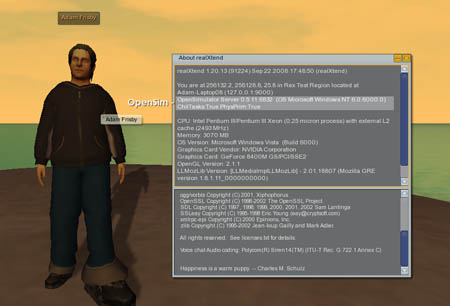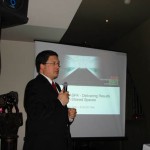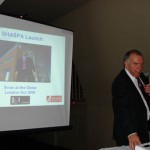The curtains are lifting between Virtual Worlds, Web 2.0, and online gaming. There are many indications of this in the news including, the rebranding of the Virtual Worlds Conf. and Expo in New York City as “Engage! Expo – 3D Web, Virtual Worlds, and Virtual Goods,” and Google’s Lively opening up an API for game development.
And, If you have been reading Ugotrade recently, you will know I have been up late several nights trying to keep up with the pace of the OpenSim, Architecture Working Group and OpenGrid Protocol teams that are proceeding at a fast clip with their work on Web 2.0 integration for immersive Virtual Worlds (and there is still much more to write on this!).
Also, this week, there was the preview launch (the full launch is scheduled for November) of a new collaboration, “SHASPA,” between EOLUS® One and The Serious Games Institute. SHASPA was unveiled to a select audience of business decision makers at the Globe Theater, London on Wednesday.
SHASPA- making a “smart” world with “shared spaces.”
Oliver Goh said, “SHASPA” is a unique cooperation to bring together Virtual Worlds (OpenSim, Second Life®), Web 2.0 Applications and the world of mobile applications….”
The pictures above show Oliver speaking (far left) and David Wortley, Director of the Serious Games Institute (SGI) at Coventry (far right), and some of the audience (center). I recognize several very important virtual world pioneers and innovators in the midst of the frey – Rohan Freeman (CEO of the Sine Wave Company), Prof Jeremy Watson (Arup), Dr Anthony Dennis (infoterra), and Dave Taylor, Programme Lead, Virtual Worlds and Medical Media at Imperial College London.
EOLUS® One initially started as an innovation project with the focus to develop new service oriented offerings for the real estate industry. Oliver explained to me:
The focus is on sustainable real estate, enhancing the structural and technical performance of properties which will be the first use case for SHASPA. SHASPA uses the combined power of the work done by the SGI and EOLUS One to create Smart Shared Spaces for various industries. The first use case will be in the Real Estate industry to revolutionize approaches to facilities/property performance optimization and energy management.
RealXtend harnesses OpenSim as engine for their server side development
Adam Frisby sent me the picture opening this post today. Adam pointed out It shows:
…Realxtend just running under OpenSim rather than the forked version of OpenSim realXtend did. It’s been converted to a set of OpenSim plugins – we’re still at a semi-preliminary stage, however, we’ve got Rex avatars and a few other features now working.
Realxtend is now able to leverage the OpenSim core, and OpenSim developers can work with realXtend innovation as plugins. For more details on this modular integration see my previous post. This modular architecture will create many new opportunities for mashups. And the Web 2.0 integration and interoperability work that is central to the OpenSim vision will be aligned with the advanced 3D Internet layer realXtend has been building on top of it.
On their diverse and multifaceted team, RealXtend has a number of world class game developers who have in a very short time progressed rapidly towards the goals Tony Manninen, Ludocraft, described to me back in February, “making sure the realXtend development reaches the required quality and performance standards you would expect from MMOGs.”
And as Jani Pirkola, Project Manager for RealXtend, points out:
For realXtend it means that we can have all the OpenSim development directly benefit realXtend, whether it is Web 2.0 or other features.
Web Friendly Standards for Virtual Worlds
I am off to London next week to the Virtual Worlds Conf an Expo. But, while I am very excited to meet old and new friends there, it is disappointing to note that the open source developer communities and the interoperability and open protocol efforts of OpenSim and Linden Lab are sadly unrepresented in London.
Making virtual worlds part of the fabric of the internet and everyday computing will not happen because some arbitrary standards body pontificates on elaborate requirements and then tries to get the backing of big business to implement their standards from top down. There are many white papers on why this old fashioned way of developing standards is not applicable to the fast moving internet environment.  As David Levine, IBM, so nicely put it a while back, interoperability and standards for virtual worlds:
will emerge battered byte by battered byte from the hands of grubbie techies each with an agenda. Except on Second Life some of us are blonde, with a pert smile but yeah….
It is, in my view, unfortunate that Dr Yesha Y Sivian, Metaverse1, in his talk “Virtual Worlds State of Standards (SOS): MPEG-V, Metaverse1, Open-SIM and more” has put OpenSim in his title (and Architecture Working Group in the body of his abstract) when he does not seem to have (yet) invited anyone from OpenSim or Architecture Working Group or OGP to represent their own work. Again, unfortunately, a panel including key industry leaders and representatives from OpenSim and Architecture Working Group did not get the opportunity to present in London because Dr Sivian’s proposal gave the conference organizers the impression there was already a “similar panel.”
MPEG-V and Metaverse 1 are Dr Yesha Sivian’s projects and they are at a very early stage of development (basically an effort to define a set of requirments and garner business support for the notion of creating so called MPEG-V standards). To have credibility, in my view, these projects need to engage with other groups that are working on standards and actually have working code, as Architecture Working Group and OpenGrid Protocol (OGP) do.
There are some common misunderstandings about the approach of the Architecture Working Group that should be cleared up.
As key architects of OpenGrid Protocol (OGP), and the Architecture Working Group, frequently stress, OGP is a point of departure. While its focused on the existing code of OpenSim and Second Life, the overall framework is as broad, or broader than the meteverse work. The goal is to create a fully described set of web based protocols and formats which will do anything MPEG-V wants to do, but meshed far more fully into the web.
Metaverse1 needs to be in dialogue with the standards work that has already produced code, if they are serious about creating good standards.
Out of the Trough of Disillusionment onto the Slope of Enlightenment
It seems Virtual Worlds may have started onto the Slope of Enlightenment (see Gartner Hype Cycle). Virtual Worlds, and immersive Virtual Worlds (in particular Second Life® and OpenSim), continue to garner broad consumer interest. And, the ability of Virtual Worlds to deliver added value in key areas of collaboration and energy conservation is fueling a a lot of interest from education and enterprise.
While worries of depression and recession in the global economy abound, and the internet is abuzz with discussion of Joe The Plumber (as Mitch Kapor noted in Twitter: “Not since Nixon have we heard so much about plumbers”).
Nevertheless, there has been quite a steady flow of positive news from Virtual Worlds. See Caleb Booker’s roundup and Virtual World News and check for yourself. And just in, Forbes.com post, “A ‘virtual’ Escape from Economic Pain,” After scanning my reader I checked my perception in Twitter and quickly got replies from Mitch Wagner of Information Week.
@MitchWagner – while you didn’t find any negative stories have you seen an increase in positive stories in mainstream media?
Recents News Events of Note
The coming of age of Open Source Virtual worlds is attracting some mainstream attention now. One of the leading authorities on Open Source Software and Services, OStactic has several recent posts on OpenSim and Open Source Virtual Worlds. And, of course, I was thrilled that Ugotrade got a mention in the most recent one, Open Source Virtual Reality Spreads Out.
Wikitecture on O’Reilly Radar
Joshua-Michele Ross gave an excellent write up today of Wikitecture a project I have followed from its inception to proof of concept in Second Life®. The mainstream recognition of the value of Wikitecture is really exciting. Recently Studio Wikitecture won Architecture for Humanity’s Founders Award for their submission; a health facility in Nepal. And Ross of O’Reilly radar offers high praise:
Wikitecture is first sophisticated tool I have seen in 3D where programmed logic provides a clear structure to facilitate collaboration. Are there other radical examples of collaboration taking place that we should be looking at?
The Inaugral Sinewave Pub Quiz on OSGrid.org
This was a really fun event. Read all about it on Adam Frisby’s blog including a technical write up and more on the most excellent bot-in-residence Chinzy Quizmaster running the Sinewave Quizbot code. But, most importantly, don’t miss the next one while you still have a really good shot at the $500 prize! The Pub Quiz is a load testing event for OpenSim and OSGrid. And, as I know OpenSim has ambitions for big concurrencies in the future, try to be an early bird on this one! Next Pub Quiz: Sunday, 26th of October at 9PM GMT (1PM PST) with a Halloween theme.
“Fashion Goes 3D”
A recent post in Fortune foregrounded Shenlei Winkler’s (CEO, Fashion Research Institute), collaboration with IBM in OpenSim and Second Life (Shenlei Winkler is Shenlei Flasheart in Second Life and OpenSim). MarketWatch also featured a piece on the “multi-million IBM Global Business Services agreement with the Fashion Research Institute (FRI) to implement a first-of-a-kind Virtual World Product Lifecycle Management (PLM) Enterprise System.” in OpenSim. See the press release here and this article from Elaine Polvinen for more.







October 18th, 2008 at 11:18 pm
And, of course, mere hours after our Twitter exchange, my Google Alert for “Second Life” served up a story from Australia that was a real late-2007 style slagging of Second Life.